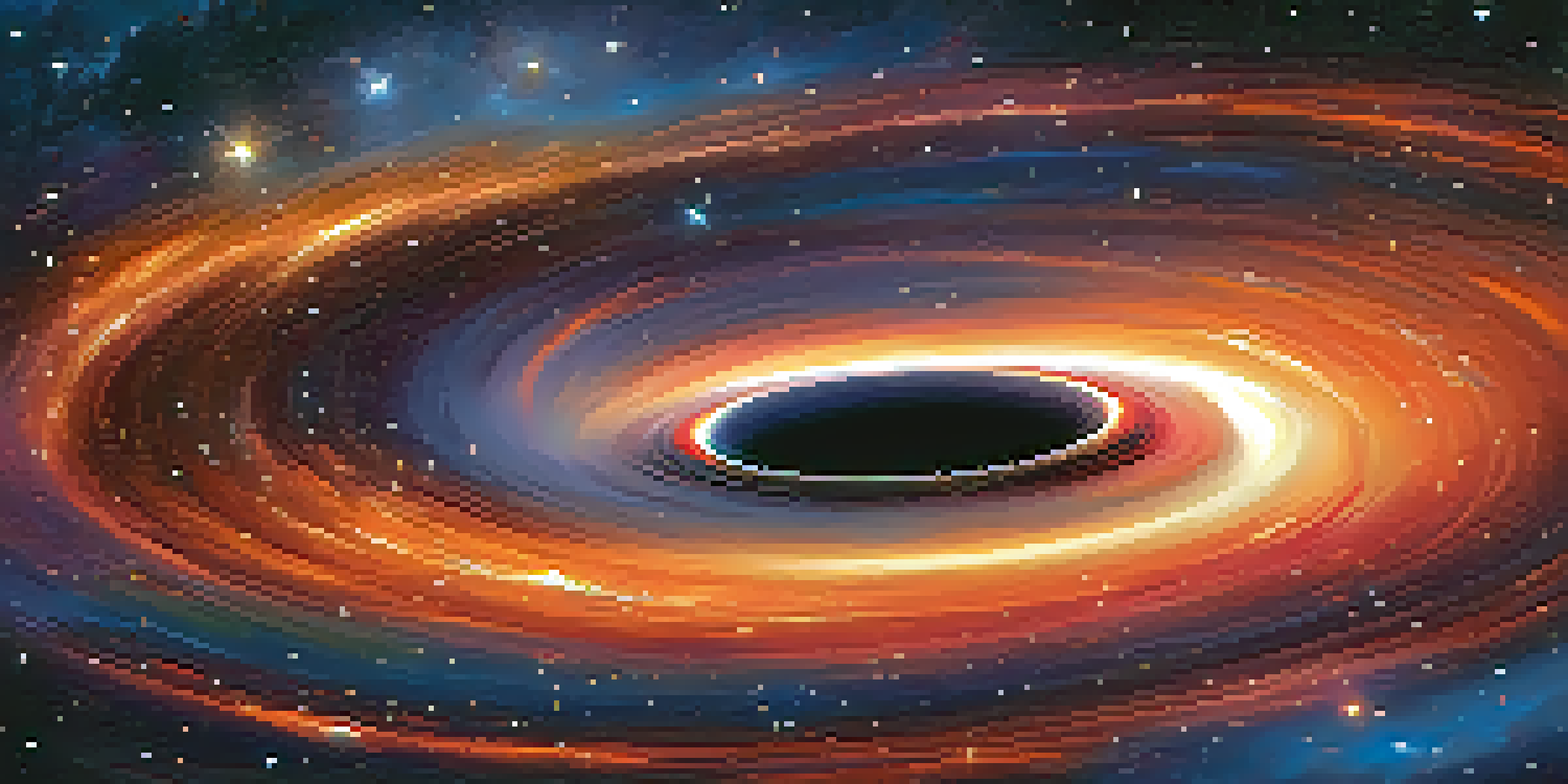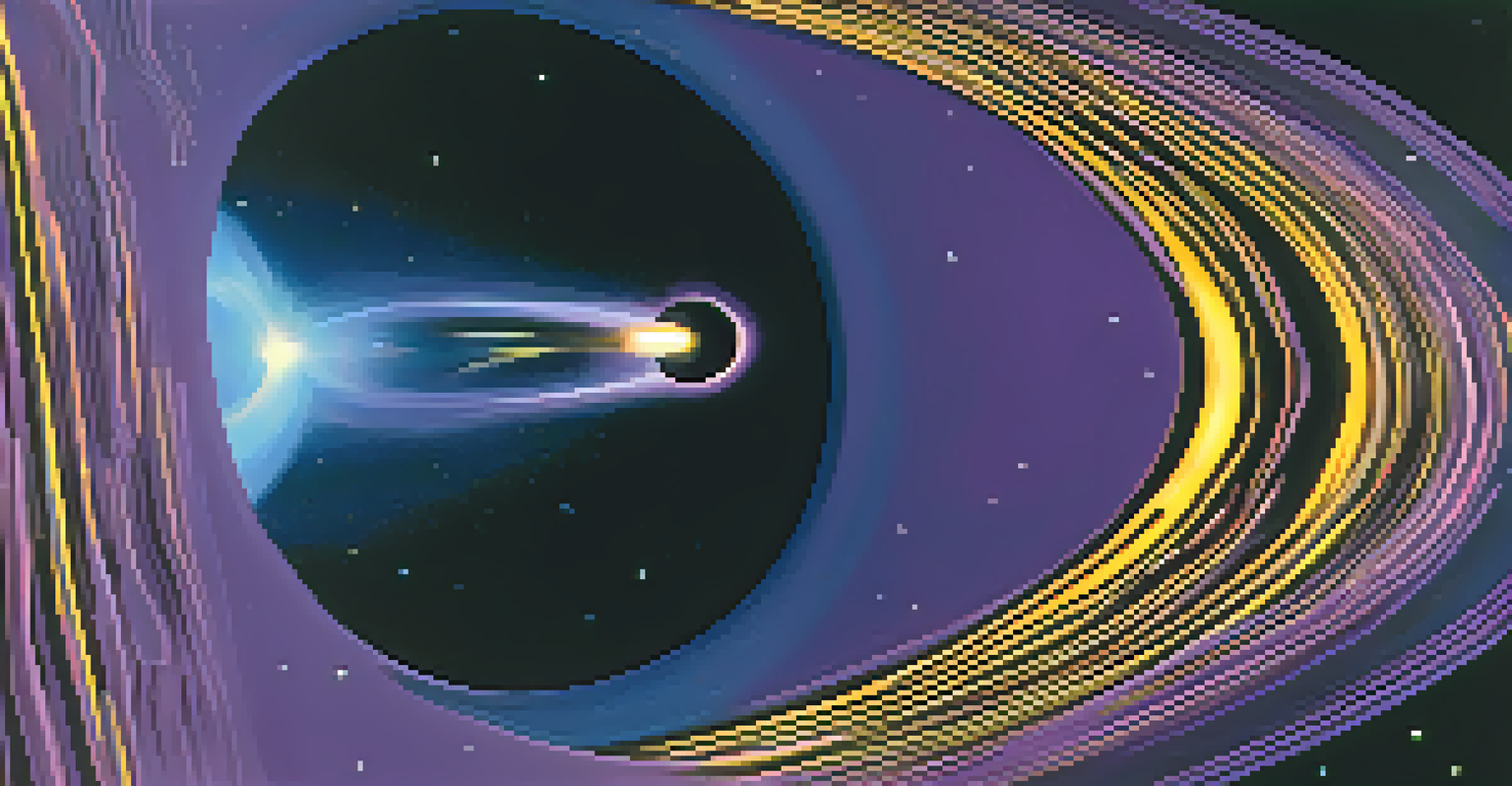Black Holes: Mysteries of the Universe Unveiled

What Are Black Holes and How Do They Form?
Black holes are regions in space where gravity is so strong that nothing, not even light, can escape from them. They typically form when massive stars exhaust their nuclear fuel and collapse under their own gravity. This collapse creates a singularity, a point of infinite density, surrounded by an event horizon—the boundary beyond which nothing can return.
Black holes are not the end of the universe, but rather the beginning of a deeper understanding of its nature.
Imagine a giant vacuum cleaner in space, pulling everything in its vicinity towards it. This is similar to how black holes operate, affecting nearby stars and gas clouds. The formation process can take millions of years, but once a black hole forms, its gravitational pull can dominate its surroundings, influencing the motion of nearby celestial bodies.
Understanding black holes begins with recognizing their immense power and the role they play in the universe. They are not just cosmic vacuum cleaners; they are crucial players in the life cycle of galaxies, often found at their centers, and they help scientists unravel the mysteries of space and time.
Types of Black Holes: A Diverse Cosmic Family
Black holes come in various types, primarily categorized into three groups: stellar, supermassive, and intermediate. Stellar black holes form from the remnants of massive stars, while supermassive black holes, found at the centers of galaxies, can have masses equivalent to millions or even billions of suns. Intermediate black holes are less understood and are thought to bridge the gap between the two larger types.

Think of these black holes as a family of different sizes and characteristics, each with its unique story. For instance, while stellar black holes might be a few times more massive than our sun, supermassive black holes can exert gravitational influence over vast distances, affecting entire galaxies. The study of these different types helps scientists understand the evolution of the universe itself.
Black Holes: Cosmic Powerhouses
Black holes are regions in space with gravitational forces so strong that they influence the movement of stars and gas, playing a crucial role in the evolution of galaxies.
The diverse nature of black holes showcases the complexity of the cosmos. Each type offers insights into various cosmic phenomena, from galaxy formation to the behavior of matter under extreme conditions, fueling ongoing research and discovery.
The Role of Black Holes in the Universe
Black holes play a pivotal role in shaping the universe. Their gravitational forces can influence the orbits of nearby stars and gas, creating dynamic interactions that can lead to phenomena such as star formation. In fact, some researchers believe that black holes may even help regulate the growth of galaxies by controlling the amount of material that falls into them.
The universe is under no obligation to make sense to you.
Imagine a cosmic traffic cop, directing the movement of celestial bodies and ensuring that the universe maintains its delicate balance. This analogy helps us appreciate the significant impact black holes have on galactic evolution and structure. Their presence can trigger new star formation or lead to the destruction of existing stars in their vicinity.
The influence of black holes extends beyond mere gravity; they also emit powerful jets of particles and radiation as matter spirals into them. These jets can affect the surrounding environment and contribute to the cosmic web, the large-scale structure of the universe. Thus, black holes are not just destructive forces; they are integral to the universe's ongoing narrative.
Detecting Black Holes: How Do We Know They Exist?
Detecting black holes is a fascinating challenge, primarily because they do not emit light. Instead, scientists identify their presence through indirect methods, such as observing the behavior of nearby stars and gas. When a star orbits an invisible object, its motion can indicate the presence of a black hole, providing crucial evidence of its existence.
Think of it like trying to find a hidden object in a dark room. You can’t see it directly, but you can observe how other objects move around it. In the case of black holes, astronomers use advanced techniques like X-ray emissions from accretion disks—hot gas spiraling into the black hole—to gather data about these elusive entities. These observations have been pivotal in confirming their existence.
Diverse Types of Black Holes
Black holes come in various types—stellar, supermassive, and intermediate—each with unique characteristics that contribute to our understanding of cosmic phenomena.
Moreover, groundbreaking discoveries, such as the first-ever image of a black hole's event horizon captured by the Event Horizon Telescope in 2019, have marked significant milestones in our understanding. Such advancements not only confirm the existence of black holes but also deepen our grasp of fundamental physics and the nature of the universe.
The Mystery of Hawking Radiation
One of the most intriguing concepts in black hole physics is Hawking radiation, proposed by physicist Stephen Hawking in 1974. This theoretical prediction suggests that black holes can emit radiation due to quantum effects near the event horizon. Essentially, particles can escape the gravitational pull of a black hole, leading to the slow evaporation of the black hole over time.
Imagine a black hole as a sponge gradually leaking water. Hawking's theory implies that even the most massive black holes can lose mass and eventually disappear, challenging the traditional notion that nothing escapes a black hole's grasp. This idea has sparked endless debate and research in theoretical physics, as it intertwines the realms of quantum mechanics and general relativity.
Hawking radiation remains a theoretical concept, but its implications could revolutionize our understanding of black holes and the universe itself. It raises questions about the fate of information and the fundamental nature of reality, making black holes not only objects of fascination but also key players in the quest to unify the laws of physics.
Black Holes and Time: The Relativity Connection
Black holes also challenge our understanding of time, as described by Albert Einstein's theory of relativity. According to this theory, gravity can bend the fabric of space-time, causing time to pass differently depending on the gravitational pull experienced by an object. Near a black hole, time slows down significantly compared to areas further away.
Picture a clock ticking at different rates as you move closer to a black hole. For an observer outside the black hole, it may seem like time comes to a standstill for anything nearing the event horizon. This fascinating phenomenon has led to discussions about the nature of reality, time travel, and the universe's structure, sparking both scientific inquiry and imaginative speculation.
Future of Black Hole Research
Advancements in technology and space exploration, such as the James Webb Space Telescope, promise to unlock new insights into black holes and their fundamental role in the universe.
Understanding the relationship between black holes and time not only enriches our grasp of the cosmos but also highlights the profound implications of gravitational forces. It serves as a reminder of how interconnected our universe is, where the laws of physics create a tapestry of time, space, and matter.
The Future of Black Hole Research
The future of black hole research is brimming with potential and excitement. As technology advances, we anticipate more discoveries that could shed light on the mysteries surrounding these enigmatic objects. Upcoming space missions, like the James Webb Space Telescope, aim to observe black holes in unprecedented detail, offering new insights into their behavior and evolution.
Envision a world where we can observe the formation of black holes or directly study the effects of Hawking radiation. Such breakthroughs could revolutionize our understanding of the universe and our place within it. Additionally, advancements in gravitational wave detection have already opened new avenues for studying black holes, particularly in the merger events between two black holes.

As researchers continue to explore the cosmos, the intrigue surrounding black holes will only deepen. Their mysteries remind us of the vastness and complexity of our universe, inspiring curiosity and a relentless quest for knowledge that drives scientific exploration forward.